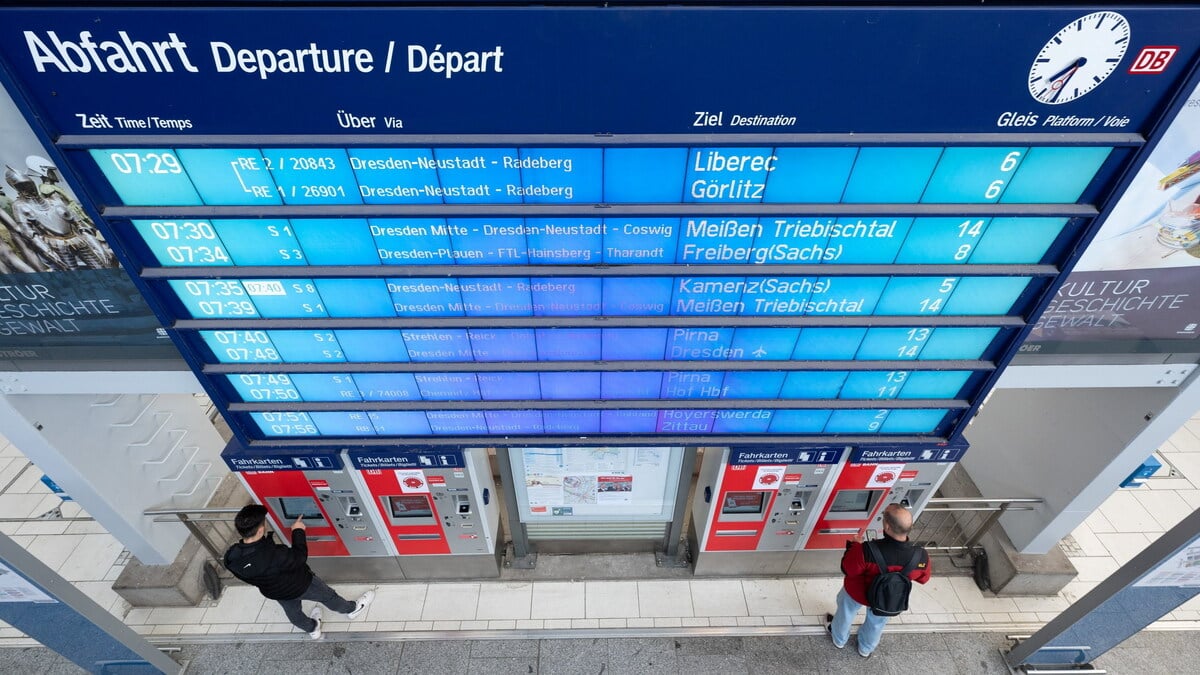9-euro ticket starts smoothly in Saxony
The 9-euro ticket has also been valid in Saxony since Wednesday. However, there are no overcrowded buses and trains. But Pentecost there is the first stress test.
3 Min.
– Passengers stand under a digital display board at the ticket machine in Dresden’s main train station.
© Sebastian Kahnert/dpa
–
Leipzig. The start of the 9-euro ticket in Saxony started largely unspectacularly. “The morning rush hour in the buses and trams runs perfectly, actually as always,” said the spokesman for the Dresden Transport Authority (DVB), Falk Loesch, on Wednesday morning. However, there is a buffer anyway because there are still up to 15 percent fewer passengers than before the corona pandemic.
9-euro ticket: problems with the app in Dresden
While there are no problems using the trams and buses, buying a ticket is a popular one Mobile ticket app however, as difficult. The DVB reported on Twitter that there were disruptions in the Handyticket payment system – due to the high demand.
Apart from the mobile phone ticket problem, the start of the 9-euro campaign planned for three months outside of Dresden is also running smoothly. “It’s a day like any other,” said Christian Schlemper from the Verkehrsverbund Oberelbe, who took the bus and tram himself in the morning. Customer service also reported nothing spectacular.
However, Schlemper expected more passengers, especially on the weekends, who will use the 9-euro ticket for trips to Saxon Switzerland or the Lausitzer Seenland, for example.
More on the subject:
The ticket is a reaction to the sharp rise in energy costs and is intended to serve as a relief measure. It is offered in June, July and August and is valid throughout Germany for journeys on buses, trams and regional trains in 2nd class. An extra ticket is issued for each month.
9 euro ticket does not have a strong effect on commuter traffic
On the other hand, the 9-euro ticket did not have a significant effect on commuter traffic at the start on Wednesday. This is indicated by an analysis by the traffic data expert TomTom for the German Press Agency. In ten major German cities and regions, the company found slightly fewer and shorter traffic jams on Wednesday morning than the day before or on Wednesday two weeks ago. However, depending on the city, the overall flow of traffic was sometimes better, sometimes worse.
Ralf-Peter Schäfer from TomTom spoke of a “trend of slight relaxation”. Overall, however, there was no uniform picture on Wednesday. Compared to Wednesday two weeks ago, traffic “flowed better in all German cities and regions considered”. Compared to Tuesday, however, there is a deterioration in Cologne, Düsseldorf and Munich. On the other hand, there was an improvement in Berlin, Stuttgart, Leipzig and the regions of Ruhrgebiet Ost and Ruhrgebiet West. In Frankfurt am Main there is virtually no change and in Hamburg the onset of rain has caused traffic to slow down.
All in all, there are many different factors when choosing the means of transport, said Schäfer. In addition to the costs, these include the weather, travel time and accessibility of the means of transport. “To what extent something like curiosity about the 9-euro ticket or expectations of overcrowded trains and buses or problems with refueling had an impact on car traffic in the morning cannot be said at the current time.”
Fuel is already significantly cheaper
The effects of the reduced energy tax were already evident at several gas stations in Saxony on Wednesday. At many petrol pumps, a liter of Super E10 cost well under 2 euros, in Dresden the ADAC petrol station finder showed a price of 1.83 euros at some petrol stations in the morning.
Because of the increased energy prices, the federal government had reduced the tax on fuel for June, July and August. It had previously been speculated that the gas stations could only pass on the so-called tank discount to consumers with a time delay. (SZ/mja with dpa)
–


